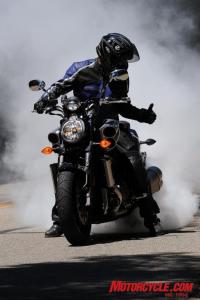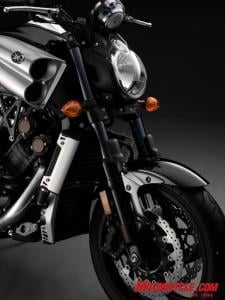Royal Distributing will bring in members of its KTM dirt bike and ATV race teams, including Canadian Motorsports Racing Club Women’s Division champion Jacqueline Ross. The CMRC will also be at the Supershow to promote its national Motorcross and ATV Racing series, and to host the Ontario Championship banquet. Dirt track racing announcer Frank Wood will be interviewing racers throughout the weekend on the Racing and Performance stage in Hall 4. Race fans can also meet some future champions as the MX Stars of Tomorrow will make an appearance. Other special guests scheduled for attendance include author and adventure rider Jeremy Kroeker and Dakar racer Lawrence Hacking. Canadian motorcycle enthusiasts can start the new year with the North American International Motorcycle Supershow. Local off-road riding associations will be represented at the Supershow. The Ontario Federation of Trail Riders, Ontario Dual Sport Club and Ontario Adventure Riders are some of the organizations who will be available to answer questions. The North American International Motorcycle Supershow takes place at the International Centre in Toronto. For more information about Supershow, visit http://www.supershowevents.com/.Racers, motorcycles and clubs featured at 2009 show
Canadian Motorcross fans can meet some of their favorite racers at the North American International Motorcycle Supershow, Jan. 2-4 in Toronto, Ontario. Show organizers have expanded the off-road segment for the 2009 event to include a large number of racers, motorcycles and clubs. 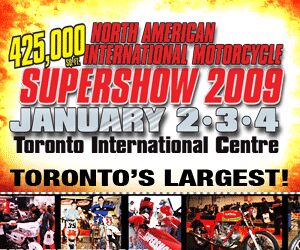
Motorcycle.Com Tips and Tricks How-To Feed
Wednesday, December 31, 2008
Supershow expands off-road segment
Diposkan oleh edie di 11:15 AM 0 komentar
Label: off-road segment, Supershow expands
December 2008 recall notices
Ducati, Harley-Davidson, Kawasaki, and Triumph issued recall notices through the National Highway Traffic Safety Administration in December 2008. Ducati is recalling 2007-2008 models of the 1098, and the 2008-2009 versions of the 848 sportbikes due to a problem with the charging system. Engine heat may cause damage to the voltage regulator of the affected bikes, leading to battery discharge. The recall affects 7,130 bikes including the 1098S, 1098R and 1098 Tricolore. Dealers will replace the voltage regulator and install a heat guard between it and the engine exhaust system. Dealers will also install a modified battery support. Motorcycles produced after May 2008 already feature these revisions. Harley-Davidson is recalling 2009 Dyna motorcycles, including the Super Glide, Super Glide Custom, Street Bob, Fat Bob and Low Rider. The affected motorcycles, produced July 24 through August 28, may have faulty welds on the jiffy stand’s spring anchor. The defect may prevent the stands from properly retracting. Harley-Davidson says 3,285 motorcycles may be affected by this problem. Harley-Davidson also issued a second recall notice for 2009 Super Glide Custom, Street Bob, Fat Bob and Low Rider motorcycles because of a fault with the fuel tank vent tube assembly. An ultrasonic weld on the anti-slosh valve of the assembly may be defective. A fuel leak may occur if the valve separates and the affected motorcycle is tipped over. Harley-Davidson says 349 motorcycles, built July 22-25, are included in the recall notice. Dealers will replace the jiffy stand spring anchors on the 3,285 motorcycles affected by the jiffy stand defect. Dealers will also inspect the fuel vent tube assembly on bikes included in the second recall notice. Kawasaki is recalling 2008 Concours 14 motorcycles due to a problem with the rear brakes. Road debris may get trapped between the rear brake pedal and the rear master cylinder actuating arm, preventing the pedal from fully releasing. This could cause the rear brake to overheat and may leading to rear brake lock-up or failure. Kawasaki has yet to provide a remedy for this problem, but will reimburse customers who experience this problem if the failure was not already covered by warranty. Kawasaki says 4,628 motorcycles are affected by this problem. Triumph is recalling 2008-2009 Thruxton motorcycles due to a problem with the front brake. Bolts installed on the front brake caliper bracket may be too short. When undoing the bolts for service, the mating threads on the caliper mounting may become damaged, potentially causing the brake caliper to come loose. Riders may notice a “clunk” noise when applying the front brake if they have this problem. Triumph will replace the bolts on the 87 Thruxtons covered by the recall notice. Triumph also issued a recall notice on 2008 Rocket III Touring motorcycles due to a problem with the saddlebag assembly. The affected bikes may be missing a weld on the back of the pannier rail supporting the bags. After time, the pannier rail may weaken and fracture, causing the saddlebags to fall off. The recall notice affects eight motorcycles, Dealers will replace the pannier rail on the affected motorcycles.
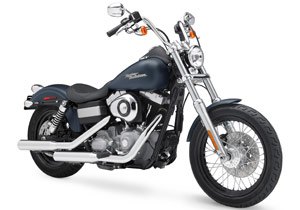
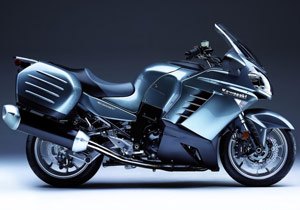
Diposkan oleh edie di 11:08 AM 0 komentar
SPEED to air AMA SX through 2013
SPEED will air events from AMA Supercross, an FIM World Championship, through at least 2013. The arrangement also gives SPEED the right to broadcast events from other Feld Motor Sports properties, AMA Arenacross, United States Hot Rod Association Monster Jam and International Hot Rod Association Nitro Jam. Contracts for the AMA Arenacross series and USHRA Monster Jam run through to 2012 while the IRA contract is a one-year deal for 2009. “This new deal with Feld Motor Sports delivers a diverse collection of racing properties for our viewers,” says Hunter Nickell, president of SPEED. “It is a great blend of competition and entertainment ... a mix that already has proven to resonate with a large number of race fans.” Chad Reed will begin his SX title defence Jan. 3 in Anaheim. Exclusive content from the AMA Supercross and AMA Arenacross series will be available during the season through SPEEDtv.com, VOD cable, iTunes video podcasts and mobile phones. Full races will be available on VOD cable and through select mobile carriers. SPEED will also offer “best of” clips of USHRA Monster Jam action through its online and wireless outlets with 2009 Freestyle events available on iTunes and Amazon for $1.99.Coverage begins with Jan. 3 season opener
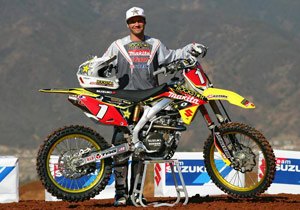
Diposkan oleh edie di 11:06 AM 0 komentar
Label: SPEED to air, SPEED to air AMA SX
2009 Star V-Max Review/Test
This is a follow-up to our quickie ride story posted just one day after sampling the bike at its world press introduction in San Diego County. Here we delve deeper into the details of the exhilarating new VMax. The word icon is described as an important and enduring symbol. For Yamaha and Star Motorcycles, the VMax stands near the top of its bikes eligible for icon status. First seen in 1985 and barely revised since, this all-new VMax has gone through a decade-long gestation, with development work going back to 1997. The first running prototype was judged to be too big and the power too linear. The 2009 Star Motorcycles VMax - an icon reinvented. Now sold under Yamaha's Star Motorcycles banner, engineers grappled with the concept of a rebirth of a legend. Star is positioning the new VMax at the edge of the expressive/aggressive personality of the modern cruiser category. As such, they use terms like hot rod, muscle, power and respect to describe what the VMax represents. To make sure Star was hitting its target audience, they conducted extensive market research with focus groups. Owners of the previous generation (which have an average age of 45-plus years) insisted a new version should have improved handling, increased power, a better riding position and continued use of shaft drive. And they were adamant for Star to use a V-Four engine and "keep the V Boost!" Key to the new VMax's success is a cast-aluminum frame that uses the giant engine as a stressed member. Bringing the VMax into the 21st century required enormous improvements to the flexi-flyer steel chassis of the old bike, so they threw it out and created an aluminum frame that uses the imposing engine as a stressed member for added rigidity. But getting a long, shaft-driven chassis to handle up to Yamaha's standards proved to be the most challenging aspect of the new bike, causing a delay to the bike's introduction until they got it right. The production version of the chassis consists of a cast-aluminum perimeter-style frame and new alloy swingarm. The subframe is made from Controlled-Fill cast-aluminum sections and extruded-aluminum. The chassis' geometry is closer to cruiser specs than sportbike numbers, with a 31.0-degree rake, 148mm of trail, and a 66.9-inch wheelbase. The previous model had sportier geometry: 29.0 degrees, 119mm, and 62.6 inches, respectively. This latest Max is about an inch wider and 3.7 inches longer overall. It all adds up to a machine with immense visual punch. The VMax's crowning accents are the aluminum air intake scoops that are now functional. The scoops are hand-polished to a fine luster (taking 40 minutes each!) then are clear-coated for an enduring shine. A large tachometer figures front and center with an inset digital speedometer. Tank-top info screen is small and hard to see while riding. Upon firing, the VMax settles into a steady but menacing rumble. The V-Four, with its contra-rotating balance shaft, is quite smooth, but a rider never forgets there is something substantial reciprocating between the knees. A blip of the throttle reveals a fairly heavy flywheel effect, as revs don't soar as quickly as smaller, sport-oriented engines. Though built as compact as possible, the 1679cc V-Four VMax motor is a substantial lump. Exhaust cams are gear-driven by the chain-driven intake cams. Forged-aluminum pistons sit atop fracture-split connecting rods, just like the latest sportbike motors. A convoluted exhaust system spits spent gasses out of titanium-skinned quad-exit mufflers. When building a replacement motor for an icon like the VMax, Yamaha/Star engineers knew they had to recreate a legend. While the old 1198cc V-Four was the bees' knees in 1985, it would take a large injection of power to be king of the hill in 2009. The mantra of the muscle-car era was "there's no replacement for displacement," and the new VMax hums the same tune. While its 66mm stroke was retained, the '09 Max gets a big-bore treatment by enlarging its cylinders from 76mm to 90mm. This yields an engine with 481cc extra, a 40.2% bump to 1679cc. Like the upcoming Aprilia V-Four Superbike engine, the VMax uses a chain to drive the intake cams, and from there a gear-set turns the exhaust cams, keeping the engine as short as possible. Valve-adjustment intervals are only every 26K miles. Star also tightened up the 70-degree vee cylinder angle to 65 degrees, also the same as the Aprilia mill. Combined, this tightened up the distance between the cylinder heads by a little more than 1 inch, and the monster motor is 7mm shorter overall. Much of this new engine uses technology seen on Yamaha's top-line sportbikes. A Mikuni fuel-injection system uses a quartet of 48mm throttle bodies with 12-hole injectors, and it's operated by Yamaha's ride-by-wire Chip-Controlled Throttle (YCC-T). The three-processor ECU measures parameters (wheel speed, crank position, temperature, etc) every 1/1000th of a second. Interestingly, a Star-supplied chart says YCC-T also takes into account a lean-angle sensor, which, along with the standard ABS's wheel-speed sensors, could be deployed as a traction-control system. A look at our tire-melting video shows this not to be the case. Also borrowed from Team Blue's R-series sportbikes are variable-length intake stacks (YCC-I) that use 150mm snorkels for strong torque at low revs. At 6650 rpm, the trumpets raise up to reveal shortie 54mm intakes for a V-Boost-like top-end hit that voraciously rockets the bike quickly through the gears. Inside the motor are more sportbike-derivative pieces. Pistons are made from lightweight forged aluminum, and they rise and fall on the 180-degree crank inside ceramic-composite cylinder linings. The connecting rods are fracture-split and carburized for strength. The new combustion chamber is much flatter (a 29-degree included valve angle) and nets an 11.3:1 compression ratio which requires premium fuel. Magnesium engine covers try to keep weight down as much as possible. Spent fuel exits into four header pipes that join in a large under-swingarm collector before flowing into a pair of four-exit mufflers with titanium skins. Inside are an oxygen sensor, two catalyzers, and an EXUP power valve. What it all adds up to is a colossal 197 crankshaft horsepower at 9000 rpm. The final version of the previous VMax (last sold in '07) was rated at a paltry 133 hp at 8000 rpm, a whopping 48.0% less. Prodigious, too, is the new Max's torque production. Its 122 ft-lbs at 6500 revs dwarfs the 86.8 ft-lbs at 6000 rpm of the old bike to the tune of 40.6%. There is so much power on tap that a Star rep related a story of how its rear tire was slipping on a rear-wheel dyno drum when testing its max power. Even adding a passenger didn't completely stop the slipping! I didn't manage to get him to reveal what numbers came up on Yamaha's Dynojet, but reading between the lines, we expect rear-wheel dyno figures approaching 180 hp. Note that Suzuki's B-King pumps out about 160 horses at the back wheel. With nearly 180 rear-wheel horsepower on tap, the VMax gets down the road like nothing else on it. The VMax is fitted with a drive system that helps and hurts. Hydraulic clutch actuation eases lever effort, and gearbox throws in the 5-speed tranny are short and precise. A race-style slipper clutch works okay, but it seems a bit incongruous to be doing high-rpm downshifts on a so-called cruiser. However, this is no ordinary cruiser and, in fact, might better be labeled something like a muscle naked. Star's Warrior is correctly termed a power cruiser, and the VMax is certainly something quite different. The VMax's rear wheel is driven by a shaft, creating some suspension issues but enhancing its tire-smoking corner-exit abilities. While the gearbox is first-rate, the shaft-drive system partially falls on the negative side of the ledger. Focus groups may have insisted on a shaftie, but this arrangement has its dynamic compromises, no matter how well it's designed. It's heavier, so a rear suspension can't react as quick, and it also makes the bike suffer a jacking effect that results in a stiffer and higher rear end when under power. However, this shaft-drive byproduct has hooligan benefits of its own. Without much rearward weight transfer, the reasonably sticky 200mm Bridgestone BT028 has a snowball's chance in hell of not melting when the V-Four is given its head. If you've even been foolish enough to want to mimic the rear-wheel-sliding corner exits of pre-traction-control GP riders, the VMax stands head and shoulders above anything else on two wheels. Tire-spinning corners exits have been part of my fantasy world that rarely transfer into actuality, but Mr. Max makes them ear-to-ear-grinningly real. In regard to the bike's ultimate acceleration, the VMax is absent a probable electronic trick and equipped with an unexpected one. First, we're thrilled to report the ECU doesn't limit power in the lower gears like on many other modern hyperbikes. Electronic intervention comes into play once 220 kph (136.7 mph) is reached, as this is the Max's top-speed limiter. However, to not handcuff dragstrip performance, the limiter is lifted to a 230-kph (142.9 mph) threshold when a quarter-mile acceleration run is sensed! For what it's worth, I saw 145 mph on the speedo before I ran out of open road. When it comes time to shed speed, the new VMax is worlds apart from the wimpy brakes of its forbear. Up front, a four-position lever actuates a Brembo radial-pump master cylinder that feeds a pair of 6-piston radial calipers biting on 320mm wave-type discs. They proved to be very powerful but not overly sharp. A Brembo rear master cylinder powerfully fires a single-pot caliper and 298mm wave rotor, and it was when using the rear brake that I was grateful for the bike's standard ABS which isn't intrusive. In terms of real-world usability, the VMax performs better than expected, although it's a bit clumsy at lower speeds. The narrow handlebar and cramped riding position of the old bike has been opened up by moving the grip position an inch further forward and about a half-inch taller. The seat height is listed at a modest 30.5 inches, but its broad seating area gives narrow-hipped people like me a bit of struggle to reach the ground firmly with both feet. A stepped seat-back isn't just for comfort; it's also to keep you aboard the bike during 1G acceleration. Extra menace can be found in the carbon-fiber section of the Star accessory catalog, accented by billet-aluminum bling. Few materials are as emblematic of contemporary speed and racing as is lightweight carbon fiber, and Star delivers with an assortment of lovely composite pieces manufactured in-house. Tasty carbon bits include fenders, tank covers, seat cowls and side covers, but the beautifully made stuff isn't cheap. A set of the C-F air intake scoops costs a whopping $999.95. Functional components include a flyscreen, touring windshield, hard saddlebags and a passenger backrest. An optional tail pack can attach to the passenger seat or an accessory aluminum luggage rack. Upping the bling factor is as easy as bolting on some billet aluminum covers for the cams, master cylinders and swingarm pivot. The VMax's riding position is open and comfortable for rides longer than a quarter-mile. Underneath the seat is 3.96-gallon fuel tank, same as the old bike, which helps lower the bike's CG. The VMax manages decent heat control through its dual radiators that keep its frontal area as slim as possible. Out of Ramona, stuck in traffic, I could feel a little heat on my ankles and shins, but not bad considering the engine's enormous output. There are decent views out of the bar-mount mirrors for keeping an eye on your tail during your inevitable extra-legal antics. Freeway cruising is very comfortable for a naked, as a rider is sitting down in the bike, making even a 90-mph lope (with its overdriven fifth gear) quite bearable. A 2-year warranty adds peace of mind. Star should be commended for the suspension it fitted to the Max. Both ends are produced by Soqi, a Yamaha subsidiary, and both the 52mm fork and single shock are adjustable for spring preload and both compression and rebound damping. But their best feature is tools-free knurled knobs to easily dial in optimum rebound damping at both ends, plus rear compression damping; a screwdriver needs to be unsheathed only for front compression. The rear end also has a handy hydraulic preload adjuster on the bike's left side that can be altered on the fly if you're flexible - otherwise, do it easily at a stop. Although there are better bikes for cutting up the twisties, the VMax acquits itself well for a machine of its size. Who wants to rumble? More successful is the new VMax's handling qualities, one of the old bike's weakest aspects. Now with the new aluminum chassis, a beefy fork and a forged-aluminum lower triple clamp and a cast-aluminum upper, the big Star is ready to intimidate lesser riders on pure sportbikes down a canyon road. Although it makes a Suzuki SV650 feel like a mountain bike in comparison, its handling is better than expected, with a chassis that feels stiff and responsive in steering transitions and a fork that offers decent front-end feel. You don't have to be a racetrack refugee to drag pegs on the VMax, but available lean angle is actually very respectable for a beast like this. Any handling deficiencies it has are related to throttle response and the shaft drive. The YCC-T is endowed with a program to reduce engine braking feel by letting a bit of fuel seep through on trailing throttle, and this works seamlessly most of the time. But in some instances, the compression-braking effect is quite pronounced and, worse, unpredictable when it happens. Chopping the throttle mid-corner can unsettle the chassis, and a rider can feel some drivetrain lash with an uncertain throttle hand in corners. The 2009 VMax - like nothing else. Recreating an icon is never easy, but that's exactly what Star and Yamaha have done with the 2009 VMax. It has a few flaws and limitations, but its overall persona extends the Max's icon status. It's as distinctive as bikes come, it has terrific attention to detail, and it offers a thrill ride that can't be equaled by anything else on two wheels. Just 2500 units (with commemorative badges) will be available for the 2009 model year, and more than half are already sold. You only have until October 31 to get your order in on the '09 VMax. Those who ordered early should see their bikes by the first part of November.
______________________________
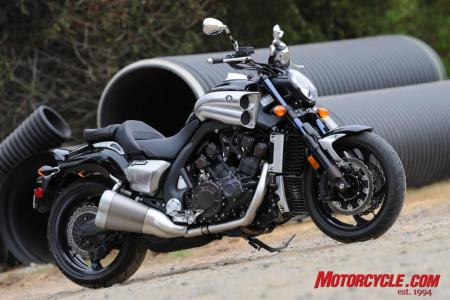


The Heart of the Beast
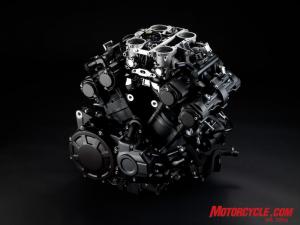
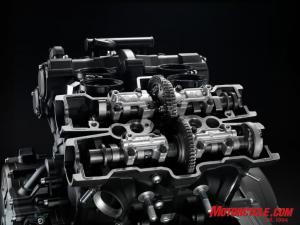
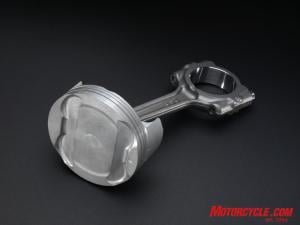
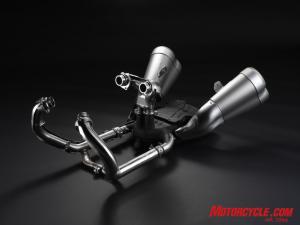
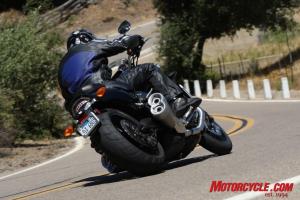
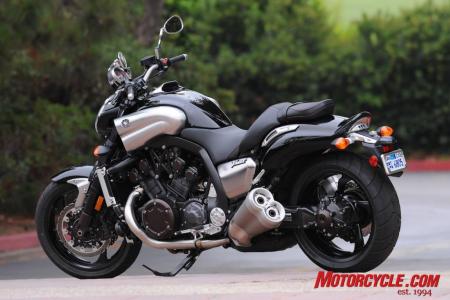
Dressed to the Nines 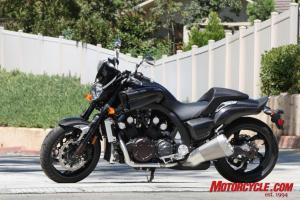
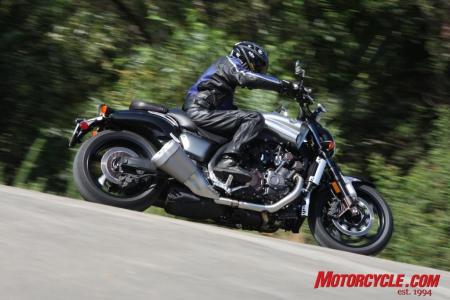
The suspension is good stuff, but it is faced with the formidable task of controlling a hefty machine and its shaft-drive dynamics. Action from the titanium-oxide-coated fork legs is quite good, even with substantially increased spring rates. But the rear end often struggles with isolating bumps, faced as it is with the shaft-drive compromises. Backing off rear preload and compression damping soothed things somewhat, but it never responded like an optimized chain- or belt-driven bike. 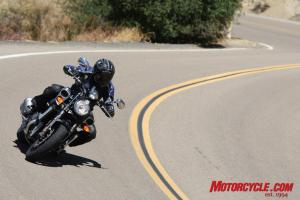
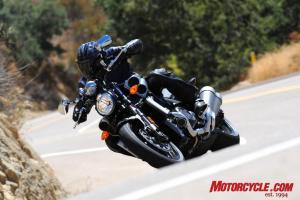

When I first heard about the new VMax, I had two thoughts: First, it was about damn time! Second, hanging a $17,990 price tag on a Japanese bike can be akin to wearing cement shoes. But while I still wonder how well second- and third-year models will sell, I do see a lot of value in this scintillating machine.
Highs: Sighs:
Diposkan oleh edie di 11:03 AM 0 komentar
Label: 2009 Star, V-Max Review
Supershow 2009
Now in its 33rd year, the show has not only grown in size, but has diversified to include trailers, ATVs and scooters. The show will also feature custom choppers, vintage bikes, vendors and clubs to check out. Plenty of interesting folks will be at the Supershow to meet and greet show attendees such as Lawrence Hacking with his Dakar bike, custom builder Steve Broyles, who will be bringing his latest and greatest creations, and Bar Hodgson with his 2008 land speed record attempting Team Arrow Bonneville Streamliner. Whether you are looking for bike gear, bike books, bike accessories or even a new bike, you are likely to find the goods you desire at the North American International Motorcycle Supershow. The North American International Motorcycle Supershow runs from Friday Jan. 2 (10a.m-10p.m.) Saturday, Jan. 3 (10a.m-10p.m.); Sunday, Jan. 4 (10a.m.-6p.m.) at the International Centre – 6900 Airport Rd. Mississauga Visit http://www.supershowevents.com/ for more info.Show spans 425,000 square feet
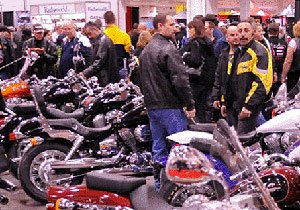 British bike expert Mike Partridge will be running a seminar on Saturday evening and will be on hand to answer questions all weekend. A couple of wordsmiths will also be in attendance to talk shop and sign books. Motorcycle Therapy author Jeremy Kroeker and Mark Richardson, who recently wrapped up his publicity tour for Zen and Now: On the Trail of Robert Pirsig and the Art of Motorcycle Maintenance will both be on hand.
British bike expert Mike Partridge will be running a seminar on Saturday evening and will be on hand to answer questions all weekend. A couple of wordsmiths will also be in attendance to talk shop and sign books. Motorcycle Therapy author Jeremy Kroeker and Mark Richardson, who recently wrapped up his publicity tour for Zen and Now: On the Trail of Robert Pirsig and the Art of Motorcycle Maintenance will both be on hand.
Diposkan oleh edie di 10:52 AM 0 komentar
Label: Supershow, Supershow 2009
Kawasaki to quit MotoGP
British motorsports site Autosport.com reports the Japanese manufacturer will announce its withdrawal from MotoGP racing on Jan. 5, 2009. A Kawasaki withdrawal would leave riders John Hopkins and Marco Melandri without a ride and reduce the MotoGP grid to 17 entrants and four manufacturers. If Kawasaki does withdraw from MotoGP, it would follow other Japanese manufacturers who John Hopkins had a disappointing 2008 season with his performance hampered by an injured ankle. Marco Melandri also had a poor 2008 season and was looking to turn things around with Kawasaki. Recent performance may also be a factor for Kawasaki to pull out of MotoGP. Ramona, Calif. native Hopkins and Australian Anthony West had difficult seasons in 2008, finishing 16th and 18th respectively in a field of 18 regular competitors. In August, Kawasaki signed Marco Melandri to replace West in 2009. Melandri finished the 2008 season sandwiched between Hopkins and West in 17th place. Hopkins, Melandri and test rider Olivier Jacques participated in the test session of the 2009 Kawasaki Ninja ZX-RR, Nov. 26-28 on Australia’s Phillip Island circuit. Related Reading Reports from Europe say Kawasaki is pulling the plug on its MotoGP race team
have recently pulled out of major motorsport competitions. Honda announced in early December its withdrawal from Formula One and AMA Road Racing while Suzuki and Subaru both opted to shut down their World Rally Championship programs. The current economic situation was cited as a main factor behind the announced withdrawals. 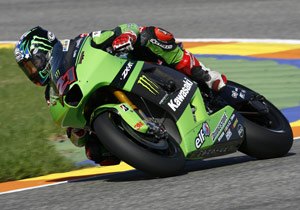
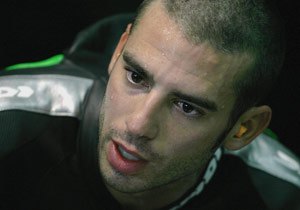
MotoGP: Kawasaki, Suzuki finish tests
Kawasaki Japan Tour
Diposkan oleh edie di 10:43 AM 0 komentar
Thursday, December 18, 2008
The Streets a Racetrack
Excess. For good or for bad, it’s something that has plagued me ever since I can remember. Whether it’s riding, partying, working-out, or [insert your activity here], you can count on me to totally overdo it. Thankfully, as I’ve grown, I’ve finally begun to recognize my peculiar trait and under normal circumstances I can cope pretty well. That is until I recently got the keys of one shiny new Ducati Desmo D16RR.
There’s just something about racing around on a loud, scratch that, ground trembling V-4 powered and street-legal 2006-spec MotoGP bike. The fact that you’re riding on a machine that costs more than most people’s car can put a pretty healthy grin on your face. Add in the 180-some horsepower at your right wrist’s disposal and a person like me is as giddy as a 16-year-old spun off a 4-pack of Red Bull.
And this in essence is the problem with Ducati’s D16RR. You see a person like me, just has to use all 180 of those horsepower pretty much everywhere he goes, all the time. The visceral thrill of the Ducati’s 990cc engine when it bursts alive at 10,000 rpm is pure addiction. The way the front wheel creeps toward the sky, while the engine screams as if it is only moments away from exploding is simply irresistible.
I absolutely love this motorcycle as it is embodies everything awesome about sportbikes, but, alas, Ducati will you please make us return it. My brain, and driver’s license for that matter, can only take so much abuse.
Diposkan oleh edie di 3:08 PM 0 komentar
Label: Racetrack, The Streets
Millen to Ring in 2009 with Truck Backflip

Rhys Millen seeks redemption for what was supposed to be a New Year’s celebration a year ago before a training accident derailed his plans.
Millen will attempt to become the first person to complete and land a backflip in an off-road truck. Set to take place at the Rio, Millen’s flip demands the truck to travel a distance of 80 feet at a height of 50 feet. During his final practice before the 2007 Red Bull New Year’s event, Millen overshot the landing, resulting in injury, damage to his vehicle and his withdrawal from the event. The 36-year-old New Zealand native is fully recovered and more determined than ever. Millen’s motorsports credibility is unrivaled. He was the 2005 Formula Drift champion and 2008 Red Bull Drifting World Championship winner and Pikes Peak International Hill Climb world record holder, and has been the lead stunt driver in several commercials and movies, such as Dukes of Hazzard and Fast and Furious: Tokyo Drift.

Robbie Maddison will follow up his history-making motorcycle distance jump with another world-first performance.
Shortly after Millen’s performance, Robbie Maddison, a 27-year-old Aussie, will jump his bike more than 120 feet high and land on the top of the 96-foot-high and 40-foot-deep replica Arc de Triomphe in front of Paris Las Vegas. Upon completing the jump, he will then drop off the Arc and freefall 50 feet to a massive landing ramp below. This follows his 322-foot-long jump last New Year’s Eve.
In addition to the ESPN telecast, the show will be simulcast live on www.ESPN360.com. A limited number of tickets will be available to witness Millen’s flip. Viewing of Maddison’s jump is free to the thousands of revelers on the world famous Las Vegas Strip.
For event information, as well as information on Maddison and Millen, visit www.redbullnewyearnolimits.com.
Diposkan oleh edie di 2:59 PM 0 komentar
Label: Millen to Ring, Truck Backflip
Suzuki Announces 09 GNCC & WORCS Lineup
Joshua Strang and Charlie Mullins will ride the race-proven Suzuki RM-Z450s in their pursuit of the 2009 GNCC championship. Coming off a stellar 2008 season in which Team FMF Suzuki captured 13 straight podium finishes, as well as five overall victories, the team’s goal for ‘09 is to capture the elusive GNCC number one plate. In addition, Strang will be looking to best his sophomore season which included a string of second place finishes and his first overall victory. While Mullins looks to improve upon his numerous podium finishes including one overall victory. Strang and Mullins kick off their quest at the GNCC season opener in River Ranch, Fla., Feb. 28 – March 3, 2009.
“We are really excited for the 2009 racing season to begin,” said Mike Webb, manager, Team FMF Suzuki Off Road. “Joshua had an incredible sophomore year last season. I know he has stepped up his pre-season training even more than last year and I can’t wait to see him take on Florida. In addition, we are working to get Charlie dialed in on the RM-Z450. Last year, Charlie had a slew of podium finishes as well as an overall victory. With his skills and his will to win, we are looking forward to great results racing GNCC.”
In the World Off Road Championship Series, Nathan Woods is healthy and ready to compete on his Suzuki RM-Z450. In 2009, Woods will pursue his third WORCS championship. While in the WORCS Pro2 class, Jonathan Davis will be out to capture the number one plate for the team. Woods and Davis kick off the first of 10 races in Phoenix, Ariz., Jan. 16 – 18, 2009.
“We look forward to going racing with the lineup that we have in 2009 for both GNCC and WORCS,” said Mike Webb, manager, Team FMF Suzuki Off Road. “With proven riders in Strang, Mullins, Woods and Davis, we are set in our quest for the number one plate in their respective series.”
For more information, visit www.teamsuzuki.com or www.suzukicycles.com.
Diposkan oleh edie di 2:55 PM 0 komentar
Label: Suzuki Announces, Suzuki Racing
Wednesday, November 12, 2008
MotoGP Riding Secrets DVD
These are the questions put to the best riders on the planet, those competing in the 2008 MotoGP Riding World Championship. Starting, stopping, cornering, sliding, crashing, overtaking, training, believing and winning. It's all in here in the MotoGP Riding Secrets DVD.
MotoGP Riding Secrets reveals the secrets directly from the stars of MotoGP Riding, including Jorge Lorenzo, Chris Vermeulen, Casey Stoner, Valentino Rossi, Colin Edwards, Nicky Hayden, Loris Capirossi. As a bonus, this DVD features Casey Stoner's Ducati broken down by the important components of the current motorcycles used on the MotoGP Riding circuits.

Diposkan oleh edie di 1:23 PM 1 komentar
Label: MotoGP Riding, MotoGP Riding Secrets DVD, Riding Secrets
2009 Ducati Streetfighter First Look

One lovely Italian evening the 1098 Superbike shared a bottle of vino with the Hypermotard, nine months later the Ducati Streetfighter was left on the Bologna firm's doorstep.
Set to hit dealers in the Spring of 2009, the Ducati Streetfighter blends 1098 performance with a stripped-down Monster/Hypermotard look. Sourcing the Desmo Testastretta Evoluzione powerplant, the Streetfighter commands a claimed 87.5 lb-ft of torque and 155 horsepower from the L-Twin.
The 1099cc engine (104mm bore x 64.7mm stroke) features Marelli fuel injection. The air pumped through the 4-valve cylinder heads will exit out undertail twin stainless steel pipes which Ducati promises “sound as mean as they look.” Remember, this is a streetfighter, so it’s okay to be mean. The distinctive Ducati sound will also include the rattle of a dry multi-plate clutch.
Housing the liquid-cooled mill is a purpose-built trellis frame. Ducati claims the frame, large fork clamps and a longer swingarm deliver “a chassis geometry special to the Streetfighter.” Hard numbers from the spec sheet indicate a 58.1-inch wheelbase with 25.6-degree rake.
Suspension comes via 43mm fork and monoshock, both from Showa and fully adjustable. Like many other Ducati models an “S” version is available, featuring Ohlins components. Differences between the standard and “S” include 10-spoke light alloy wheels on the regular, while the “S” model utilizes 5-spoke forged Y-shape Marchesini hoops.
The Streetfigher S also features the high-tech Ducati Traction Control and Ducati Data Analysis systems right off the showroom floor.
No word yet on US pricetags for either version of the Streetfighter but both will benefit from top-line braking components - with a pair of 330mm rotors squeezed by 4-piston, radial-mount Brembo monobloc calipers. A single 245mm disc with 2-piston caliper takes care of things out back.
Ducati chose Milan to reveal the new Ducati Streetfighter, alongside its 1198 Superbike (featured in another article). And while the Streetfighter is the headliner, Ducati also announced some minor changes to the 2009 street bike lineup – like the Hypermotard and Multistrada now being available in pearl white. The GT1000 is now also available in a special touring version.
Ducati didn’t limit its Milan news to new motorcycle designs either, as the Bologna firm also revealed a new logo. The old ‘D’ logo is replaced by a red shield with new graphics.
Displacement: 1099cc
Bore and Stroke: 104 x 64.7mm
Compression Ratio: 12.4:1
Horsepower: 155hp @ 9500rpm
Torque: 87.5 lb-ft @ 9500rpm
Fueling: Marelli fuel injection
Wheelbase: 58.1 in
Rake: 25.6 degrees
Front Suspension: 43mm inverted Showa fork, fully adjustable
Rear Suspension: Showa monoshock, fully adjustable
Front Brake: Dual 330mm disc, 4-piston Brembo monobloc calipers
Rear Brake: Single 245mm disc with 2-piston caliper
Diposkan oleh edie di 1:09 PM 0 komentar
Label: 2009 Ducati Streetfighter, Ducati Streetfighter, Ducati Streetfighter First Look
Monday, November 10, 2008
The Honda V4 Concept
Thursday November 6, 2008
To be perfectly honest, I didn't think much of Honda's V4 Concept when it appeared at the Intermot show about a month ago. In my eye, it was too conceptual and pie-in-the-sky to be connected to reality. Well, it turns out the public and media's response was so strong that Honda is using the V4 Concept as inspiration for a V4-powered bike that will be built in only 18 months.
Bucking the horsepower-obsessed trends that drive most sportbikes, Honda claims that they "...understand the global trend today that motorcycle users see increasing value in more emotional and sensual performance during the real world riding experience rather than absolute performance measured in numeric specifications." Translated roughly? Honda wants to build cool bikes that people feel passionate about.
To take a closer look at the inspiration behind the bike that will start production in 18 months and and get introduced halfway through 2010, here's our Honda's V4 Concept Photo Gallery.
Diposkan oleh edie di 9:48 PM 0 komentar
Label: Honda V4, The Honda V4 Concept, V4 Concept
2009 Suzuki Boulevard M90 Power Cruiser
The new Suzuki Boulevard M90 is a smaller-engined version of the generously endowed M109R, a power cruiser which boasts the self-proclaimed largest cylinders of any roadgoing, gasoline-powered vehicle. Suzuki says they had always planned to spin off a smaller iteration of the M109R, and now seems like the perfect time for a more balanced, reasonably sized cruiser.
With more user-friendly ergonomics and riding dynamics (not to mention a more buyer-friendly price of $9,999), the M90 is a more accessible option than the M109R... but does it stir up as much desire? I recently piloted the M90 up and down Highway 1 through Monterey and Big Sur and will post my review soon, but in the meantime take a look at the 2009 Suzuki M90 Photo Gallery.
Related:
2008 Suzuki Buyer's Guide
Photo © Brian J. Nelson
Diposkan oleh edie di 9:46 PM 0 komentar
Label: Power Cruiser, Suzuki Boulevard
Harley-Davidson Motorcycle History
Harley-Davidson Motorcycle History
- 1870 Birth of William A. Davidson, Milwaukee, WI.
- 1876 Birth of Walter Davidson, Milwaukee, WI.
- 1880 Birth of William S. Harley, Milwaukee, WI. As he was born just after Christmas, his parents gave him the middle name “Sylvester.”
- 1881 Birth of Arthur Davidson, Milwaukee, WI.
- 1901 William S. Harley, aged 21, completes a blueprint for an engine designed to fit into a bicycle.
- 1903 Harley and Arthur Davidson build the first production Harley-Davidson in 1903. It features a 3-1/8-inch bore and a 3-1/2-inch stroke yielding 7.07 cubic inches (116cc). They make a more powerful motor with the assistance of Ole Evinrude – better known as the inventor of the outboard motor. It is designed for use on the wooden velodromes where popular bicycle races are held.
Harley and Davidson work in a 10 x 15-foot shed on Chestnut Street (later renamed Juneau Avenue) which is still the address of Harley-Davidson’s head office.
- 1904 The first Harley-Davidson dealer, C.H. Lang of Chicago, opens for business.
- 1906 A new 28 by 80-foot factory is built on Chestnut Street. The company has grown to have six employees. It produces its first catalog, and coins the nickname “Silent Gray Fellows.” It’s a reference to the fact that the bikes were painted dove gray, and that they were quietly reliable. (Evidently, the company’s founders were unaware that loud pipes save lives.)
- 1907 William A. Davidson joins the firm. Harley-Davidson Motor Company is incorporated, with stock shared by the Harley and the three Davidson brothers.
- 1908 Walter Davidson scores a perfect 1,000 points at the 7th Annual Federation of American Motorcyclists Endurance and Reliability Contest. Three days after the contest, Walter sets the FAM economy record at 188.234 miles per gallon.
Perhaps impressed with that reliability, Detroit becomes the first city to buy a H-D motorcycle for police use.
- 1909 “The Motor Company” makes its first V-Twin. It has a displacement of 49.5 cubic inches and produces seven horsepower.
- 1910 The ‘Bar & Shield’ logo is used for the first time in 1910 and was trademarked one year later.
- 1911 The ‘F-head’ single-cylinder engine is introduced and will remain in use until 1929. (This is not a reference to “Hey, f-head!” it’s a reference to the shape of the valve ports.) It is an inlet-over-exhaust design, with an overhead intake valve (in the head like a modern motor) but a “side” exhaust valve which is in the cylinder.
- 1912 Harley-Davidson begins exporting motorcycles to Japan. Construction begins on a six-storey headquarters. The Parts and Accessories Dept. is formed. The company has more than 200 dealers across America.
- 1913 The Racing Department is formed, under the control of Bill Harley.
- 1914 Sidecars are made available. Some models are briefly available with a two-speed transmission in the rear hub. Also, belts go out of fashion – for the moment. Harley-Davidson is one of the last motorcycle manufacturers to switch from leather drive belts to chains. The leather belts slipped, stretched and rotted, so chains are a big improvement.
- 1915 H-D motorcycles become available with three-speed sliding-gear transmissions with final and primary drive on the same side.
- 1916 The Enthusiast magazine is published for the first time.
- 1917 About a third of the company’s production is purchased by the Army. To train Army mechanics, the company starts the Quartermasters School. After the war, it will be retained as the Service School, providing factory-trained mechanics for dealers.
- 1918 Almost half of all H-D motorcycles produced are sold for use by the U.S. military in World War I. After Armistice is signed, Corporal Roy Holtz becomes the first American soldier to enter Germany. He does so on a Harley-Davidson motorcycle.
- 1919 The 37-cubic-inch Sport model is introduced. It’s a horizontally-opposed, fore-and-aft V-Twin.
- 1920 Now the largest motorcycle manufacturer, H-D boasts over 2,000 dealers in 67 countries.
The factory racing team, already known as “The Wrecking Crew” because it’s become so dominant in American racing, has a small pig as a mascot. The bikes are nicknamed “hogs” as a result.
- 1925 The company adopts teardrop-shaped gas tanks (previously they were flat-topped) that give its machines a very distinct look. Joe Petrali becomes one of the first salaried “factory racers.”
- 1926 Single-cylinder motorcycles are sold first time since 1918. Models A, AA, B and BA are available in side-valve and overhead-valve engine configurations.
- 1928 The first two-cam engine is made available on the JD series motorcycles. The bike can reach a top speed between 85 and 100 mph. Luckily, this year all H-D models are also available with a brake on the front wheel. Surprisingly few Harley-Davidson riders use them, even to this day.
- 1929 The D model is introduced with a rugged, 45-cubic-inch flathead V-Twin engine. The “Flathead” motor will be sold in various guises for over 40 years.
The stock-market crash heralds the Great Depression. In 1929, the company sells 21,000 motorcycles. It’s the strongest of the dozens – if not hundreds – of motorcycle brands that were launched in the first three decades of the century; only a handful will survive into the fourth.
- 1932 The three-wheeled Servi-car begins its 41-year run. (Sure they were used to deliver great corned-beef sandwiches, but they were also used by the guys who wrote 410,000,000 parking tickets, too.)
In racing, Joe Petrali begins a string of five consecutive national championships in dirt track, as well as four consecutive hill-climb titles. (In those years, the championship was decided in a single race.)
- 1933 The company sells only 4,000 motorcycles this year. To reduce costs for competitors, the AMA creates a new racing class, Class C, based on production equipment and allowing for limited modifications. Although the original, prototype-based Class A persists, the AMA emphasizes the new class. Purists resent the change.
- 1935 Alfred Child, the company’s agent in Asia, realizes that currency exchange rates are killing sales in Japan. He convinces the company to license production of its motorcycles in Japan. The Sankyo Seiyakyo Corporation purchases tooling and begins producing Harley “clones”. They are sold under the name Rikuo, which means “King of the Road.”
- 1936 Introduction of the EL, an overhead valve, 61-cubic-inch-powered bike, which earns the nickname of ‘Knucklehead’ because of the shape of its rocker-boxes. The company also introduces an 80-cubic-inch side-valve engine.
- 1937 Petrali sets a land-speed record of over 136 mph with a streamlined Knucklehead. The first WL models are produced.
William A. Davidson dies, two days after signing an agreement that makes the company a union shop.
- 1938 Ben Campanale wins the Daytona 200 on a 45 cubic-inch WLDR. The race was run on the 3.2-mile beach course.
The Jackpine Gypsies hold the first Black Hills rally in Sturgis.
- 1941 United States enters World War II. The production of civilian motorcycles is almost entirely stopped.
- 1942 When U.S. soldiers capture their first “Wehrmacht”-issue motorcycles in North Africa, they find that the BMWs and Zundapps are better suited to tough military duty. Harley-Davidson and Indian each develop about 1,000 machines for evaluation, with shaft drives and Flat-Twin motors copied from the Germans. They are never widely issued, though the machines cost Uncle Sam a whopping $35,000 each.
Walter Davidson dies.
- 1943 William S. Harley dies.
- 1945 The war finally ends. Between 1941-45 the company produced almost 90,000 WLA models for military use.
- 1946 The 45 cubic-inch, flathead, WR production racer is made. It conforms to stricter Class C AMA rules, which are intended to reduce costs for competitors. It’s a flathead, because in Class C, flatheads are allowed to displace 750cc, while OHV motors are limited to 500cc.
- 1948 The company’s 61 and 74 c.i. OHV engines are updated with aluminum heads and hydraulic valve lifters. Also new are the one-piece rocker covers, which resemble cake pans, earning the motor the nickname ‘Panhead.’
As part of Germany’s war reparations, the Allies loot German patents. The fine, small two-stroke motors built by DKW (seen in that
company’s popular RT125) are copied by BSA (the Bantam) and Harley-Davidson, which produces the model S that will come to be known as the Hummer.
- 1949 Hydraulic front forks make their first appearance on the new Hydra-Glide models.
- 1950 Arthur Davidson dies.
- 1952 Returning servicemen seem to favor the lighter British Twins they saw “over there.” In response, Harley-Davidson creates the 45 c.i. side-valve K model. It’s a unit-construction motor – the crankcases and gearbox are one set of castings.
- 1953 Indian goes into its long, painful death throes. H-D, which celebrates its 50th anniversary this year will be only real motorcycle manufacturer in the U.S. for the rest of the century.
The aging WR and WRTT production racers are no match for the British 500s now invading the dirt tracks (and few road courses) of America. The H-D racing department counters with a new racer, the KR. Like the WR, it is a 750cc flat-head.
- 1955 The new KR begins a run of seven consecutive Daytona 200 victories, which will include the last race run on the old beach course and first one run at the new Daytona International Speedway.
- 1957 The Sportster is introduced. It is basically a larger-displacement version of the K motor, fitted with an OHV head. At 55 c.i., it offers performance to rival anything coming out of England (at least, anything coming out of England without a “Vincent” tank badge.) has a 55 cubic-inch overhead-valve engine.
- 1958 Hydraulic rear suspensions appear on the Duo-Glide.
- 1960 Harley-Davidson acknowledges the market potential of smaller machines. The company makes its first and only scooter, the Topper. It also purchases a half-interest in the Italian company Aermacchi, which produces fast and stylish single-cylinder machines of up to 350cc.
Brad Andres wins the last Daytona 200 run on the sand. 2nd through 13th (no, not 3rd, 13th) places all go to riders on KRs.
- 1961 The first Aermacchi design to reach America is the Harley-Davidson Sprint. Short-track racers are quick to realize that its good power and low center of gravity make it a winner.
- 1962 Harley-Davidson acquires the Tomahawk boat company and starts to learn about the uses of fiberglass.
- 1964 The humble Servi-Car is the first of the company’s machines to be fitted with an electric starter.
- 1965 The Duo-Glide and is fitted with an electric starter, and thus becomes the Electra-Glide.
- 1966 Riders clamoring for more power cause the company to update the old Panhead motor. The new engine has rocker boxes that resemble coal shovels. Hence, the new mill gets the nickname “Shovelhead.” This basic motor will remain in production for 20 years.
- 1968 After years of increasingly vociferous lobbying, the import manufacturers convince the AMA rules committee that the 250cc displacement advantage given to flathead motors is unfair. The AMA declares that, in the future, bikes with overhead valves (all the British and Japanese models) can also displace up to 750cc. Harley-Davidson lobbies to delay the implementation of the new rule for one more season.
- 1969 Although Harley-Davidson stock is publicly traded, it is still a relatively closely held corporation. The shareholders – perhaps sensing that the “Japanese invasion” is about to open a new front in the heavyweight category, with the Honda CB750 Four – sell the company to the American Machine and Foundry Company. AMF has hitherto been known to the American consumer as a maker of bowling balls, but it is in fact a large, diversified manufacturer.
AMF could have risen to the challenge presented by the sophisticated and comparatively affordable Honda. Instead, AMF’s managers roll a real gutter-ball. Harley-Davidson quality plummets. Before long, dealers are forced to rebuild motors under warranty and magazines are brutally critical of test bikes. Used Harleys are described as “pre-AMF” in classified ads.
- 1970 The racing department creates a new production racer, the XR-750. The motor is basically a destroked Sportster unit. It gets off to an inauspicious start; none of the factory entries reach the finish in the Daytona 200. The first Harley across the line is an ancient KRTT, ridden by Walt Fulton III.
- 1971 By mating the spare front end of the XL series with the frame and motor of the FL series, the company creates the first cruiser – the FX 1200 Super Glide.
- 1973 A new assembly plant is opened in York, PA.
- 1977 Although most Harley fans would rather forget the years in which the company was owned by AMF, there is one AMF-era bike that’s highly sought-after by collectors: the 1977 XLCR. That “CR” stands for Café Racer and the bike was only the second major project for Willie G. Davidson (the grandson of one of the founders.) While the model is prized now, it was rejected by Harley customers in 1977. Only 3,100 were sold and the model was dropped a year later – although dealers still had unsold XLCRs cluttering their showroom floors well into the ’80s.
The FXS Low Rider is also introduced this year.
- 1979 The FXEF “Fat Bob” is introduced. It’s called fat because of its dual gas tanks, and bob on account of its bobbed fenders.
- 1980 The FLT is introduced. It has rubber-isolated drivetrain and an engine and five-speed transmission which are hard bolted together.
Belts come back into fashion: a Kevlar belt replaces the chain as the final drive on some models.
The FXB Sturgis, featuring an 80 cubic-inch engine, and FXWB Wide Glide are introduced.
- 1981 After years of AMF mismanagement, Harley-Davidson has lost almost all customer loyalty and profits are in freefall. When a group of company executives led by Vaughn Beals offers to buy the division for $75 million, AMF quickly agrees.
Beals leads an amazing corporate turnaround. He funds new product development and implements world-class quality control. It’s impossible to know what would have happened to the H-D brand if Beals had not risen up to save it, but it’s certain that no one else could have done a better job at rehabilitating it.
- 1982 The FXR/FXRS Super Glide II are introduced, featuring a rubber-isolated, five-speed powertrain.
The company adopts a just-in-time inventory system on the manufacturing side, which helps to lower cost and improve quality.
- 1983 The Harley Owners Group (H.O.G.) is formed.
The company petitions the International Trade Commission (a branch of the U.S. federal government) to impose a tariff on Japanese motorcycles of over 700cc. As a result, many Japanese motorcycles that are sold as 750cc models in the rest of the world are sleeved-down to 700cc for the U.S. market.
- 1984 The 1340cc V2 Evolution engine appears on five models. Although it’s been in development since the AMF era, the motor proves the newly independent company has turned the corner in terms of build quality. It is far more reliable and oil-tight.
The Softail, which features concealed rear suspension and evokes the rigid-framed hogs of 30 or 40 years ago, meets with commercial success.
- 1986 Harley-Davidson diversifies with the acquisition of the Holiday Rambler motorhome company.
- 1987 The company makes its Initial Public Offering. Stock is traded on the NYSE, with the ticker symbol of HOG. The company petitions the ITC to relax the tariff on imported motorcycles, a year before it was scheduled to lapse. The move serves notice that Harley-Davidson is capable of competing on a level playing field, despite the fact that the Japanese companies now all make V-Twin cruisers that compete directly with the American offerings.
- 1988 Exploiting customers’ love of traditional styling, the Springer front end returns on the FXSTS Springer Softail.
- 1990 Introduction of the FLSTF Fat Boy.
- 1991 Introduction of the first motorcycle in the Dyna line, the FXDB Dyna Glide Sturgis.
- 1992 Harley-Davidson is the first company to equip all its models (except for a handful of racing motorcycles) with drive belts. Modern drive belts provide a smoother ride than chains, last longer, and free riders from the drudgery of chain lubrication and adjustment.
- 1993 H-D buys a minority interest in the Buell Motorcycle Company.
- 1994 The company enters the AMA Superbike Championship, fielding the water-cooled, DOHC VR1000. AMA rules specified that the company had to also build and sell 2,000 machines for road use, a process is called “homologation.” So, you may wonder, why have you never seen a road-going VR1000 if 2000 were sold? Because the model was homologated in Poland. By selling it there, Harley avoided U.S. liability and Poland’s lax laws allowed the barely-modified race bike to be legally licensed.
Despite being ably ridden by Miguel Duhamel, Pascal Picotte, Chris Carr and Scott Russell, the VR1000 will never win an AMA race.
- 1995 Harley-Davidsons are equipped with fuel injection for the first time.
- 1996 Sales of parts and accessories are an increasingly important part of the business – a fact reflected in the new, 250,000 sq. ft. facility the company opens in Franklin, WI.
- 1997 A new 217,000 sq.-ft. design center opens in Milwaukee. FL engine production moves to a newly purchased plant in Menomonee Falls. A new 330,000 sq. ft. plant in Kansas City takes over the production of Sportsters.
- 1998 The company opens its first foreign factory in Manaus, Brazil.
The remaining shares of Buell are also acquired.
- 1999 The Touring and Dyna lines receive the new Twin Cam 88.
- 2000 Despite spending tens of thousands of dollars in legal fees in the mid-’90s – and having initial success in its efforts to trademark the “potato-potato” sound of Harley motors – the company drops its U.S. Patent Office application. Harley-Davidson’s vice president of marketing, Joanne Bischmann, tells reporters, “I’ve personally spoken with Harley-Davidson owners from around the world and they’ve told me repeatedly that there is nothing like the sound of a Harley-Davidson motorcycle. If our customers know the sound cannot be imitated, that’s good enough for me and for Harley-Davidson.”
- 2001 The VRSCA V-Rod is introduced. The motor – which was designed with input from Porsche – is fuel injected, has overhead cams, and liquid cooling.
- 2003 It is estimated that 250,000 people come to Milwaukee to celebrate The Motor Company’s 100th anniversary.
- 2006 Fittingly, the ’06 model-year Dyna motorcycles come with six-speed transmissions.
The company announces a major new museum, scheduled to open in Milwaukee in 2008.
- 2007 Harley upgrades its Big Twin motor, stroking it out to 96 cubic inches and earning the moniker “Twin Cam 96.” The six-speed transmission from the Dyna line is added across the board.
- 2008 The Motor Company opens its impressive new museum in time for Harley’s 105th anniversary.
Diposkan oleh edie di 6:14 PM 0 komentar
Label: Harley-Davidson, Harley-Davidson Motorcycle History, Motorcycle History
